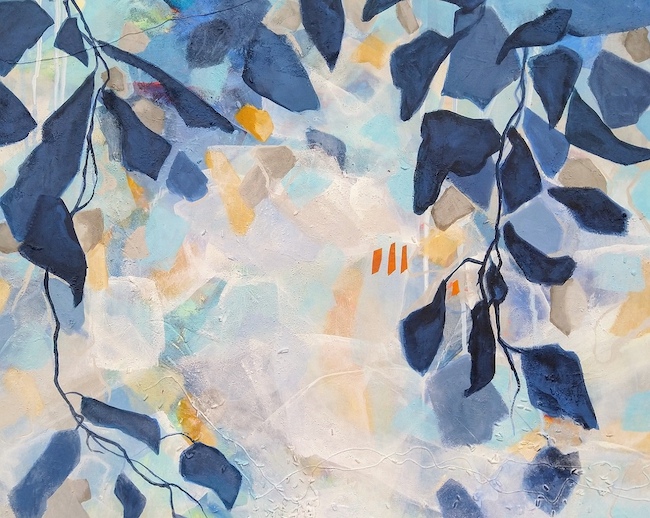L’arte attuale spesso assume connotazioni esistenziali, divenendo mezzo per liberare un’interiorità silenziosa che riesce a manifestarsi nel gesto creativo, oppure si trasforma in opportunità per rappresentare una realtà contemporanea più o meno piacevole sulla base dell’approccio all’esistenza del singolo artista; in altri casi però la necessità di esprimere le proprie sensazioni si fonde alla capacità di cogliere la bellezza, quel lato estetico lasciato indietro perché meno prioritario rispetto al sentire più profondo, eppure in grado di divenire mediazione e opportunità per trovare l’armonia perduta. Questo è il percorso creativo che contraddistingue l’artista che andremo a scoprire oggi.
Il passaggio dal Diciannovesimo al Ventesimo secolo fu caratterizzato da forti contrasti culturali e artistici a causa delle innovazioni stilistiche introdotte dall’Impressionismo, su cui si impose successivamente il Post-Impressionismo, delle teorie dei Fauves che si concretizzarono qualche anno dopo con la nascita dell’Espressionismo, e infine del diffondersi del coevo Stile Liberty, detto anche Art Nouveau, Modernismo, Arts and Crafts, Secessione viennese, a seconda del paese europeo a cui appartenevano gli artisti aderenti. I contrasti tra i movimenti dell’epoca non furono solo stilistici bensì anche filosofici perché opposti erano i punti di vista su cosa l’arte dovesse rappresentare, su quale dovesse essere il messaggio contenuto in una tela. Dunque l’attenzione estetica dell’Impressionismo, quel voler catturare la luce sottolineando la bellezza di un paesaggio, la piacevolezza del vivere, il lasciare che lo sguardo si perdesse nella natura circostante, entrò in contrasto con l’intento Espressionista di rinunciare a qualsiasi regola prospettica, a ciascuno schema armonico perché tutto ciò che era necessario fuoriuscisse dalla tela era il sentire profondo, intenso, spesso burrascoso dell’autore, poco importava se il risultato apparisse brutto, distorto o deforme. Di contro però, a sottolineare quanto il panorama artistico dell’epoca fosse diviso, si affermò anche un movimento culturale che voleva recuperare la bellezza fine a se stessa, l’abilità decorativa che doveva colpire lo sguardo prima che l’anima, e che avrebbe coinvolto differenti ambiti, dalla scultura all’architettura, dalla decorazione alla pittura, cercando di riunire il distacco tra arte e artigianato, tra il costruire e il dare vita a un’opera della creatività. L’Art Nouveau, questo uno dei nomi del movimento, sottolineò l’importanza della natura all’interno dell’esistenza, un contatto estetico ma anche necessario all’uomo per comprendere la bellezza della semplicità, di quel mondo circostante spesso in grado di far dimenticare la contingenza oggettiva non sempre appagante. Foglie, fiori, uccelli variopinti, donne iconiche eleganti ed eteree contraddistinsero i dipinti, le stampe, le vetrate decorate appartenenti a questo stile artistico in cui lo sguardo poetico era predominante su qualsiasi altra realtà. L’artista tedesca Margot Vogl abbraccia due estremi opposti, quello dell’Art Nouveau e quello dell’Espressionismo, per dar vita a uno stile delicato, leggero, impalpabile ma non orientato solo e unicamente alla ricerca esteriore bensì in grado di diffondersi al mondo emotivo in maniera altrettanto lieve quanto lo è l’apparenza delle sue tele.

Il mondo della natura, la bellezza lirica delle foglie e dei fiori fungono da mantello avvolgente per lo sguardo, trasformando le sue opere in mondi ideali all’interno di cui si ha la sensazione di poter trovare quella serenità, quella calma che troppo spesso all’esterno, nella realtà quotidiana, non è possibile avere; ecco dunque che l’arte diviene mezzo per fuggire verso qualcosa di più piacevole, per evadere verso una dimensione impalpabile, non priva di emotività bensì intrisa di sensazioni più positive che non turbolente o frastornanti.
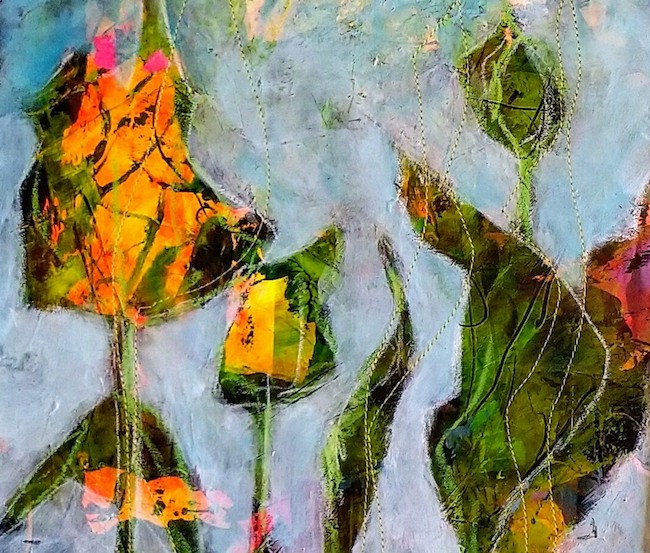
Il mondo di Margot Vogl è sognante, soffice, avvolgente per tutte quelle raffigurazioni floreali che sembrano voler invitare l’osservatore a entrare nella dimensione dell’artista, quello scrigno segreto in cui cullare i desideri più puri, in cui riporre le speranze e i desideri perché è proprio all’interno di quell’universo che l’essere umano può elevarsi, ritrovare il contatto con un sé più semplice e spontaneo; il richiamo all’Art Nouveau fuoriesce esattamente da quello scegliere foglie e fiori come base pittorica ma anche come protagonisti assoluti, in alcuni casi, di tele fresche, rassicuranti, delicate e forse proprio per questo tanto coinvolgenti.
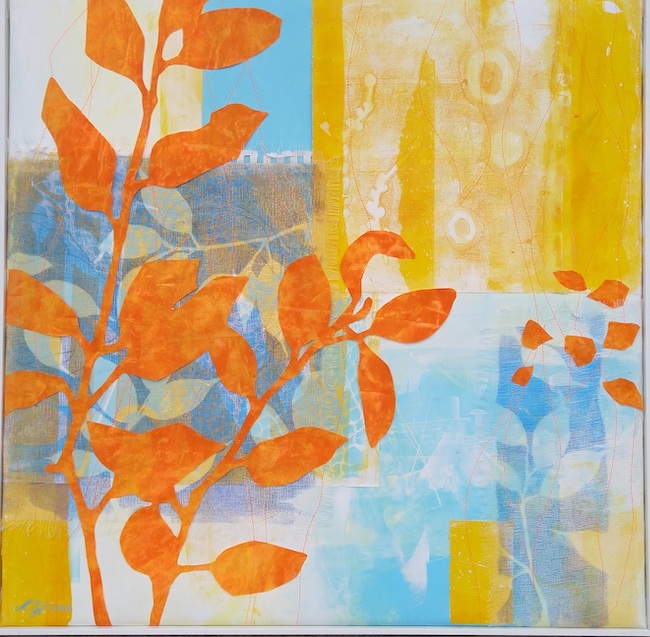
Nella tela Sommerwind (Vento d’estate) la Vogl evoca i colori della stagione più bella e spensierata, raccontandola nella sua modalità meno fascinosa forse, non descrive il mare, la spiaggia, gli scorci paesaggistici, bensì probabilmente in quella più naturale, più spontanea, bella senza il bisogno di apparire in maniera palese; quelle foglie arancioni, lo sfondo giallo e celeste riescono perfettamente a infondere la medesima sensazione di spensieratezza, di solarità e di calore di panorami più figurativi.
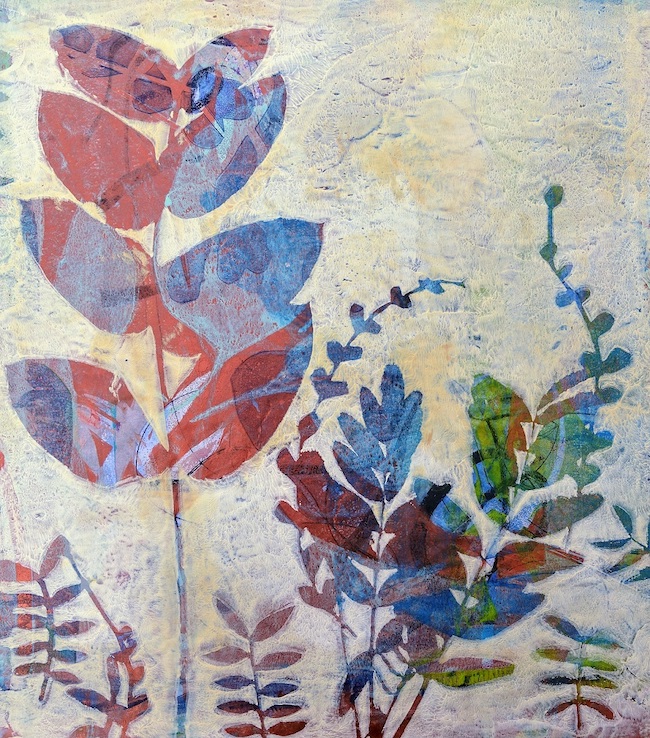
Nell’opera Das Glück wächst draußen (La felicità cresce fuori), l’artista sottolinea quanto sottile eppure solida sia la connessione tra l’animo umano e la natura in cui abita, quella capacità di interazione che spesso viene ignorata pur essendo presente, davanti allo sguardo ed è unicamente nella facoltà dell’individuo accoglierla e godere delle sue bellezze, della sua armonia, oppure continuare a fingere di non vederla malgrado lei, la natura, continui a tendere verso quel contatto emozionale; in quest’opera decisamente espressionista, le tonalità tendono verso il sogno, quel desiderio velato di incontrare la serenità esistenziale e la capacità di gioire di tutta la semplicità che apparterrebbe alla vita se l’uomo fosse in grado di scorgerne la vera essenza.
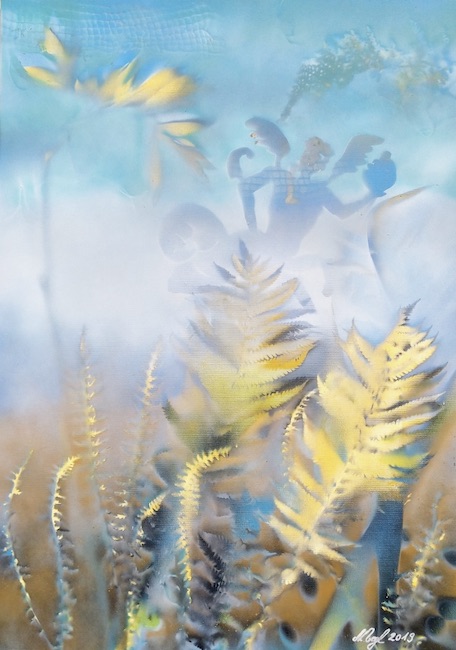
Così come in 100 Meilen unter dem Meer (Cento miglia sotto il mare), l’artista esplora il fondale marino, osservandolo come se fosse un mondo fantastico dentro cui perdersi, di cui immaginare la vita, piena di luce, non buia come invece dovrebbe essere il fondo del mare, bensì ravvivata dai colori delle piante sottomarine, delicate e fluttuanti proprio come la sua fantasia, il suo desiderio di morbidezza e di delicatezza che appartiene a tutta la sua produzione pittorica ma anche alla sua indole; anche in quest’opera ciò che emerge è la positività quasi ingenua, il desiderio di allontanarsi dagli ostacoli della quotidianità per trovare un luogo, sia esso immaginario o reale poco importa, dentro cui rifugiarsi e vivere una vita diversa.
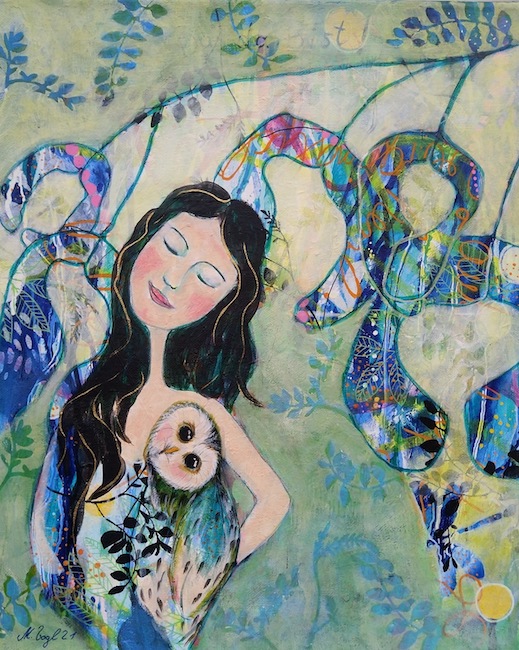
Quando introduce la figura umana Margot Vogl si avvicina alle atmosfere oniriche e al tempo stesso giocose di Marc Chagall, alla sua ingenuità rappresentativa che da sempre è in grado di elevare il pubblico di ogni età verso una dimensione fanciullesca, dove l’ambiente circostante si armonizza e asseconda l’emozione narrata; tanto leggera e serena è l’emozione che si riceve osservando le opere del maestro del Novecento, quanto distesa e sognante è quella che fuoriesce dalla tela Du und ich (Tu e io), dove l’amore raccontato non è quello tra uomo e donna, bensì quello nei confronti di un animale, una civetta, attraverso cui l’artista intende sottolineare ed evidenziare la purezza di un legame distante da ogni secondo fine, da ogni convenienza che spesso invece appartiene al rapporto tra umani. Anche in questa tela la sensazione è quella di trovarsi in un reame fiabesco dove la natura, ancora una volta, diviene palcoscenico armonico con il sentire del personaggio perché i colori si accordano con lo stato d’animo della donna, inducendola attraverso quel legame spontaneo, a riflettere su se stessa, sulla propria esistenza e sull’importanza di cercare emozioni vere, reali; solo attraverso la capacità di allontanarsi dal materialismo, dal pragmatismo della contemporaneità, è possibile recuperare la sostanza propria e di tutto ciò che appartiene al vivere.
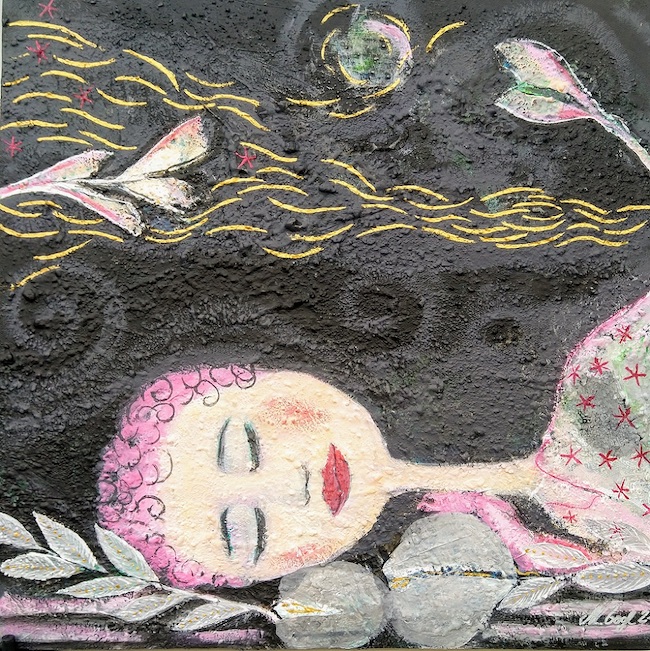
Margot Vogl necessita sperimentare e misurarsi con diverse tecniche pittoriche, pastello, acquarello, acrilico, inchiostro, collage, disegno, stampa grafica che spesso si fondono nelle sue opere per ampliare la sensazione di magia e di leggerezza che appartengono al suo stile. Ha all’attivo molte mostre collettive in Germania e all’estero – Italia, Polonia, Portogallo – e due importanti mostre personali a Monaco e a Pucheim.
MARGOT VOGL-CONTATTI
Email: margot-vogl-art@gmx.de
Sito web: https://www.margot-vogl-art.de
Instagram: https://www.instagram.com/margot.vogl/
The impalpable delicacy of Margot Vogl’s floral works, halfway between Expressionism and the aestheticism of Art Nouveau decorations
Contemporary art often takes on existential connotations, becoming a means of releasing a silent interiority that manages to manifest itself in the creative gesture, or it becomes an opportunity to represent a more or less pleasant contemporary reality on the basis of the individual artist’s approach to existence; in other cases, however, the need to express one’s own sensations blends with the ability to grasp beauty, that aesthetic side left behind because it is less of a priority than the deepest feelings, yet able to become a mediation and an opportunity to find lost harmony. This is the creative path that distinguishes the artist we are going to discover today.
The transition from the nineteenth to the twentieth century was characterised by strong cultural and artistic contrasts due to the stylistic innovations introduced by Impressionism, on which Post-Impressionism later imposed itself, the theories of the Fauves, which took shape a few years later with the birth of Expressionism, and finally the spread of the contemporary Liberty style, also known as Art Nouveau, Modernism, Arts and Crafts, Sezession, depending on the European country to which the adehernt artists belonged. The contrasts between the movements of the time were not only stylistic but also philosophical because there were opposing points of view on what art should represent, on what the message contained in a canvas should be. So the aesthetic focus of Impressionism, the desire to capture the light and emphasise the beauty of a landscape, the pleasantness of life, letting the eye lose itself in the surrounding nature, contrasted with the Expressionist intention of abandoning any rule of perspective, any harmonious scheme, because all that needed to emerge from the canvas was the author’s deep, intense, often stormy feelings, and it mattered little if the result appeared ugly, distorted or deformed.
On the other hand, however, to underline how divided the artistic scene of the time was, emerged a cultural movement that wanted to recover beauty as an end in itself, the decorative ability that had to strike the eye before the soul, and that would involve different fields, from sculpture to architecture, from decoration to painting, trying to reunite the gap between art and craftsmanship, between create and giving life to a work of art. Art Nouveau, one of the names of the movement, emphasised the importance of nature within existence, an aesthetic contact but also necessary for man to understand the beauty of simplicity, of that surrounding world often able to make us forget the objective contingency which is not always satisfying. Leaves, flowers, multicoloured birds, iconic women, elegant and ethereal, distinguished the paintings, prints and stained glass windows belonging to this artistic style in which the poetic gaze was predominant over any other reality. The German artist Margot Vogl embraces two opposing extremes, Art Nouveau and Expressionism, to create a delicate, light, impalpable style that is not only and exclusively oriented towards exterior research but is able to spread to the emotional world as lightly as the appearance of her canvases.
The world of nature, the lyrical beauty of leaves and flowers act as an enveloping cloak for the eye, transforming her artworks into ideal worlds within which one has the sensation of being able to find that serenity, that calm that all too often outside, in daily reality, is not possible; here, then, art becomes a means of escaping towards something more pleasant, of evading towards an impalpable dimension, not devoid of emotion but imbued with more positive sensations than those that are turbulent or overwhelming. Margot Vogl’s world is dreamy, soft, enveloping for all those floral representations that seem to want to invite the observer to enter the artist’s dimension, that secret treasure chest in which to cradle the purest desires, in which to place hopes and wishes because it is precisely within that universe that the human being can rise, find contact with a simpler and more spontaneous self; The reference to Art Nouveau emerges precisely from this choice of leaves and flowers as a pictorial base but also as the absolute protagonists, in some cases, of fresh, reassuring, delicate canvases and perhaps for this very reason so engaging. In the painting Sommerwind (Summer Wind), Vogl evokes the colours of the most beautiful and carefree season, telling the story in its least fascinating way perhaps, she does not describe the sea, the beach, the views, but probably the most natural, the most spontaneous, the most beautiful without the need to appear in an obvious way; those orange leaves, the yellow and blue background perfectly succeed in instilling the same feeling of light-heartedness, of sunshine and warmth as in more figurative views.
In Das Glück wächst draußen (Happiness grows outside), the artist emphasises how subtle yet solid is the connection between the human soul and the nature he inhabits, that capacity for interaction which is often ignored even though it is present, before our eyes, and it is solely up to the individual to welcome it and enjoy its beauty, its harmony, or to continue to pretend not to see it even though it, nature, continues to tend towards that emotional contact; in this decidedly expressionist work, the tones tend towards the dream, that veiled desire to encounter existential serenity and the ability to rejoice in all the simplicity that would belong to life if man were able to discern its true essence. Just as in 100 Meilen unter dem Meer (One Hundred Miles Under the Sea), the artist explores the seabed, observing it as if it were a fantastic world in which to lose oneself, to imagine life, full of light, not dark as the seabed should be, but enlivened by the colours of the underwater plants, delicate and fluctuating just like her imagination, her desire for softness and delicacy that belongs to all her painting but also to her nature; in this painting, too, what emerges is an almost naive positivity, a desire to get away from the obstacles of everyday life and to find a place, be it imaginary or real, where one can take refuge and live a different life. When Margot Vogl introduces the human figure, she draws close to Marc Chagall’s dreamlike and at the same time playful atmospheres, to his representational naivety, which has always been able to raise audiences of all ages to a childlike dimension, where the surrounding environment harmonises with and supports the narrated emotion; just as light and serene is the emotion one receives when observing the twentieth-century master’s works, as relaxed and dreamy is the one that emerges from the canvas Du und ich (You and I), where the love narrated is not that between a man and a woman, but that towards an animal, an owl, through which the artist intends to emphasise and highlight the purity of a bond far removed from any ulterior motive, from any convenience that often belongs to relations between humans.
In this canvas, too, the sensation is that of being in a fairy-tale realm where nature once again becomes a stage that is in harmony with the character’s feelings, because the colours are in tune with the woman’s state of mind, leading her, through that spontaneous bond, to reflect on herself, on her own existence and on the importance of seeking real, true emotions; only through the ability to distance oneself from materialism, from the pragmatism of the contemporary world, is it possible to recover one’s own substance and that of everything that belongs to living. Margot Vogl needs to experiment and measure herself with different painting techniques, pastel, watercolour, acrylic, ink, collage, drawing, graphic print, which often merge in her artworks to amplify the feeling of magic and lightness belonging to her style. She has had many group exhibitions in Germany and abroad – Italy, Poland, Portugal – and two major solo exhibitions in Munich and Pucheim.


